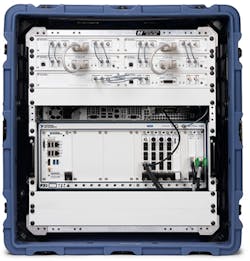National Instruments (NI) continues to maintain its prominent role in the 5G communications space, demonstrated by the company’s recent unveiling of its 5G New Radio (NR) Test User Equipment (UE) (see figure). The NI Test UE is fully compliant with the 3GPP Release 15 non-standalone (NSA) specification. It emulates the entire UE operation and provides real-time performance information when connected to a base station (gNodeB). According to NI, “The NI Test UE can be used to test components, subsystems, and/or full base-station equipment at every earmarked 5G band in the lab or in the field.”
The NI Test UE gives customers access to a UE that complies with the Release 15 NSA specification before commercial hardware is even available. According to Sarah Yost, senior solutions marketing manager, SDR, at NI, “As we’re getting ready to release 5G, it’s really important that we have ways to test out all of these new handsets with the other side of the network, i.e., the base station (gNodeB), in a lab environment and in the field before it gets too far.”
The NI Test UE gives customers a standard-compliant system ahead of the availability of commercial hardware.
Software-defined radio (SDR) lies at the heart of the NI Test UE. Yost explains, “With our Test UE, we’ve taken all the technology that’s in a handset and we’ve built that up with software-defined radios (SDRs). Even though this is a lot bigger than an actual handset, there’s a lot of power and computation happening.”
Specifically, NI built the front ends of the Test UE with its own Universal Software Radio Peripheral (USRP) radios. The solution also contains additional amplification to achieve the full UE power level for field trials. In addition, the NI Test UE has a chassis full of FPGAs so that all processing can be performed in real time.
Yost also points out that “one of the great benefits of building the Test UE with SDRs is that we can also upgrade our software. We’re currently on Release 15 running NSA. As the standards evolve, we can simply do a software update to get to the latest version and add new features like standalone (SA) mode.”
With the NI test UE, users are able to monitor link performance in real time using the visualized measurements on the graphical user interface (GUI). Link performance can be analyzed and debugged offline with additional data logs.
The NI Test UE allows users to select a center frequency anywhere between 500 MHz and 6 GHz. It supports a 4-×-2 multiple-input, multiple-output (MIMO) configuration for 5G NR. Furthermore, NI can provide customers with an optional hard case for easy transporting.


